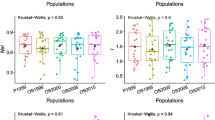Abstract
Allozyme variation at ten polymorphic loci and mating system was studied in three small isolated relict populations (4.4 to 22 ha) and in three artificial stands of Pinus sylvestris from the Kremenets Hill Ridge and Maloe Poles’e. It was established that the mean heterozygosity of 130 to 140 year-old trees from natural populations (H O = 0.288; H E = 0.277) was substantially lower, compared to 30 to 40 year-old trees from artificial stands (H O = 0.358; H E = 0.330). The observed heterozygosity of seed embryos (H O = 0.169 and 0.180) was substantially lower than of the mature trees from populations and artificial stands, respectively. In the embryo samples, irrespectively of the forest stand origin, substantial hetedrozygote deficiency was observed (at six to eight loci), compared to the Hardy-Weinberg expectations. The proportion of cross pollination in the populations and artificial stands was low, t m = 0.588 to 0.721; and t m = 0.455 to 0.837, respectively.
Similar content being viewed by others
References
Myakushko, V.K., Sosnovye lesa ravninnoi chasti USSR (Pine Forests of the Plain Part of Ukrainian Soviet Socialist Republic), Kiev: Naukova Dumka, 1978.
Delgado, P., Cuenca, A., Escalante, A.E., et al., Revista Chilena de Historia, Natural, 2002, no. 75, pp. 27–37.
Davis, B.J., Disk Electrophoresis: II. Methods and Application to Human Serum Proteins, Ann. N.Y. Acad. Sci., 1964, vol. 121, p. 404.
Altukhov, Yu.P., Geneticheskie protsessy v populyatsiyakh (Genetic Processes in Populations), Moscow: Akademkniga, 2003.
Rousset, F., Genepop’007: A Complete Reimplementation of the Genepop Software for Windows and Linux, Mol. Ecol. Resour., 2008, vol. 8, pp. 103–106.
Nei, M., Genetic Distance between Populations, Am. Nat., 1972, vol. 106, pp. 283–292.
Swofford, D.L. and Selander, R.B., BIOSYS-1: A FORTRAN Program for the Comprehensive Analysis of Electrophoretic Data in Population Genetics and Systematics, J. Hered., 1981, vol. 72, no. 4, pp. 281–283.
Ritland, K., Extensions of Models for the Estimation of Mating Systems Using n Independent Loci, Heredity, 2002, vol. 88, pp. 221–228.
Dinamika populyatsionnykh genofondov pri antropogennykh vozdeistviyakh (Dynamics of Population Gene Pools under Anthropogenic Influence), Altukhov, Yu.P., Ed., Moscow: Nauka, 2004.
Politov, D.V., Population Genetics and Evolutionary Interactions of Pinid Species (Family Pinaceae) of Northern Eurasia, Extended Abstract of Doctoral (Biol.) Dissertation, Moscow, 2007.
Korshikov, I.I., Pirko, N.N., Mudrik, E.A., and Pirko, Ya.V., Maintenance of Genetic Structure in Progenies of Marginal Mountainous and Steppe Populations of Three Species of Pinaceae Lindl. Family in Ukraine, Silvae Genet., 2007, vol. 56, no. 1, pp. 1–10.
Korshikov, I.I., Kalafat, L.A., Pirko, Ya.V., and Velikoridko, T.I., Population-Genetic Variation in Scots Pine Pinus sylvestris L. from the Main Forest Regions of Ukraine, Russ. J. Genet., 2005, vol. 41, no. 2, pp. 155–166.
Shigapov, Z.Kh., Frequency of Self-Pollination in Natural Populations and in the Scotch Pine Forest Seed Plantations, Lesovedenie, 1997, no. 1, pp. 51–56.
Hosius, B., Bergmann, F., Konnert, M., et al., A Concept for Seed Orchards Based on Isoenzyme Gene Markers, Forest Ecol. Management, 2000, no. 131, pp. 143–152.
Bush, R.M., Evidence for the Adaptive Significance of Allozymes in Forest Tree, Proc. New Forests Preserved at IUFRO Meeting, Corvall, 1990, vol. 6, nos. 1–4, pp. 179–196.
Author information
Authors and Affiliations
Corresponding author
Additional information
Original Russian Text © I.I. Korshikov, L.A. Kalafat, A.N. Lisnichuk, T.I. Velicoridko, E.A. Mudrik, 2011, published in Genetika, 2011, Vol. 47, No. 7, pp. 937–944.
Rights and permissions
About this article
Cite this article
Korshikov, I.I., Kalafat, L.A., Lisnichuk, A.N. et al. Allozyme variation of seed embryos and mating system in relict populations of scots pine (Pinus sylvestris L.) from the Kremenets Hill Ridge and Maloe Poles’e. Russ J Genet 47, 829–835 (2011). https://doi.org/10.1134/S1022795411070106
Received:
Accepted:
Published:
Issue Date:
DOI: https://doi.org/10.1134/S1022795411070106



